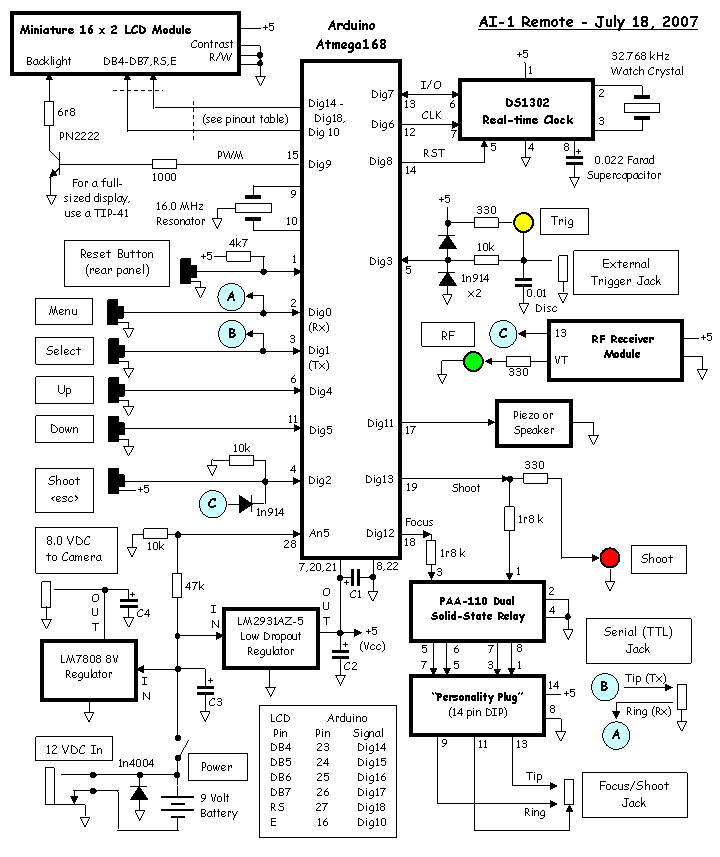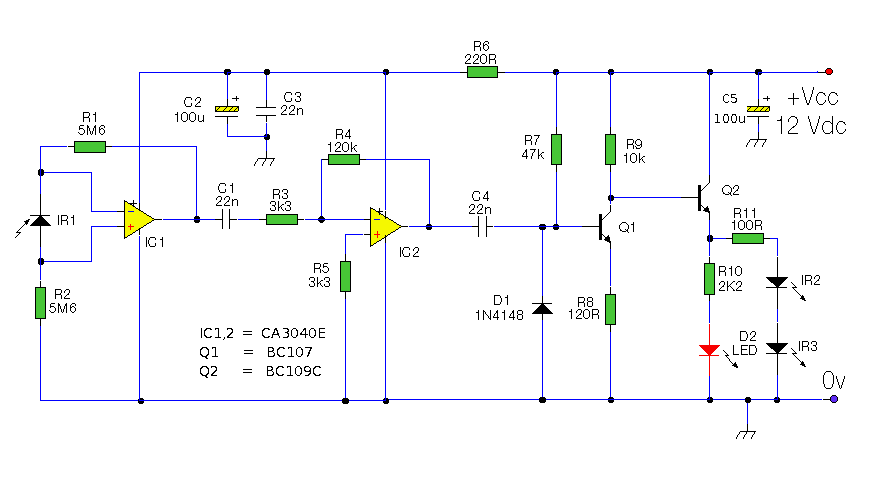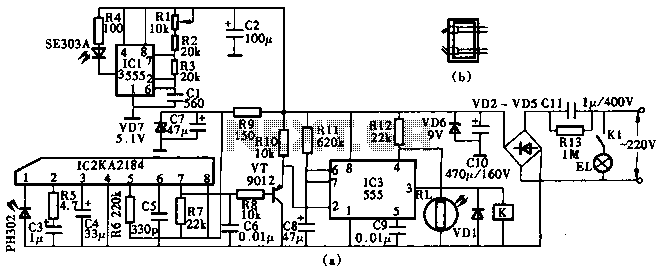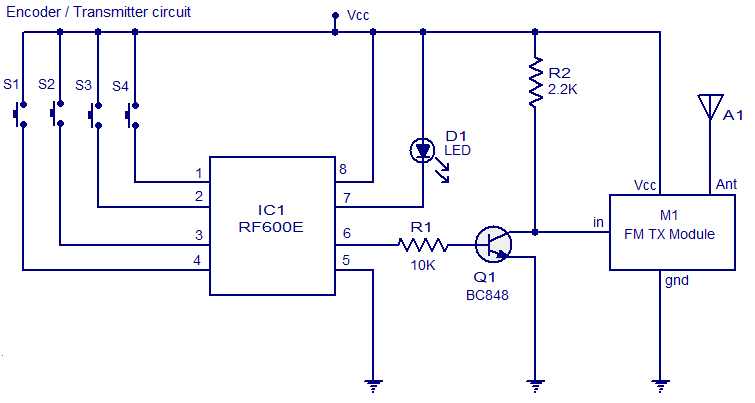
Infrared Remote Controls
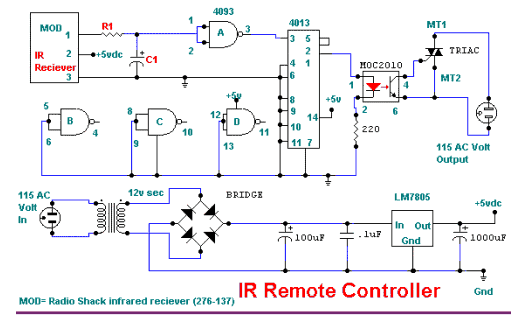
This circuit enables the control of any equipment operating at 115 volts AC. It utilizes the Radio Shack infrared receiver module (MOD), part number 276-137, which can also be sourced from other suppliers listed on the Links page. The MOD is designed to accept a 40 kHz infrared signal modulated at 4 kHz. When an appropriate signal is received, the MOD output goes low. The sensitivity of the MOD is adjustable through the resistor R1 and capacitor C1, with R1 values potentially reaching up to 10,000 ohms and C1 values around 40 µF. This configuration helps prevent the unit from activating under normal lighting conditions, and experimentation with these values is encouraged to find the optimal settings. The output from the 4013 flip-flop IC toggles on and off in response to the received infrared pulse. This output activates the MOC optical coupler, which subsequently switches on the triac, supplying power to the AC load.
The circuit operates by first receiving an infrared signal through the MOD, which is sensitive to specific modulation frequencies. The 40 kHz signal is crucial for the MOD to recognize valid commands, while the 4 kHz modulation ensures that the circuit can differentiate between noise and actual signals. The resistor R1 and capacitor C1 form a low-pass filter that determines the sensitivity of the MOD. By increasing the resistance or capacitance, the circuit can become less responsive to ambient light, thereby reducing false triggers.
Once the MOD detects a valid infrared signal, it outputs a low signal to the 4013 flip-flop, which is configured in a toggle mode. The 4013 IC is a dual D-type flip-flop that can store binary states. Each time it receives a low signal from the MOD, it toggles its output state. This toggling action serves as a control mechanism for the MOC optical coupler, which is designed to isolate the low-voltage side of the circuit from the high-voltage AC load.
The MOC optical coupler plays a critical role by providing electrical isolation between the control circuit and the AC load. When the output from the 4013 goes high, the MOC activates, allowing current to flow through its output side. This current triggers the triac, which is a semiconductor device capable of controlling AC power. The triac remains on until the current flowing through it drops below a certain threshold, effectively allowing the circuit to control the power to the connected AC device.
In summary, this circuit represents an effective solution for wirelessly controlling AC-powered devices using infrared signals. By adjusting the components to suit specific environmental conditions, users can achieve reliable operation while maintaining safety through electrical isolation.This circuit will allow you to turn on any piece of equipment that operates on 115 volts ac. The reciever circuit is based on the Radio Shack infrared receiver module(MOD), part number 276-137. It is also available from some of the other sources listed on my Links page. The MOD accepts a 40khz IR signal that is modulated at 4 khz. When a signal is recieved the MOD will go low. The sensitivity of the MOD is set by different values for R1 and C1. The values for R1 may need to be as high as 10, 000 ohms and for C1 40uf. This will prevent the unit from turning on under normal lighting conditions. You will need to experiment with the vaules that work best for you. The output of the 4013 chip a flip flop toggles on and off with the reception of a IR pulse. The output of the 4013 turns on the MOC optical coupler which in turn switches on the triac and supplies power to the AC load. 🔗 External reference
The circuit operates by first receiving an infrared signal through the MOD, which is sensitive to specific modulation frequencies. The 40 kHz signal is crucial for the MOD to recognize valid commands, while the 4 kHz modulation ensures that the circuit can differentiate between noise and actual signals. The resistor R1 and capacitor C1 form a low-pass filter that determines the sensitivity of the MOD. By increasing the resistance or capacitance, the circuit can become less responsive to ambient light, thereby reducing false triggers.
Once the MOD detects a valid infrared signal, it outputs a low signal to the 4013 flip-flop, which is configured in a toggle mode. The 4013 IC is a dual D-type flip-flop that can store binary states. Each time it receives a low signal from the MOD, it toggles its output state. This toggling action serves as a control mechanism for the MOC optical coupler, which is designed to isolate the low-voltage side of the circuit from the high-voltage AC load.
The MOC optical coupler plays a critical role by providing electrical isolation between the control circuit and the AC load. When the output from the 4013 goes high, the MOC activates, allowing current to flow through its output side. This current triggers the triac, which is a semiconductor device capable of controlling AC power. The triac remains on until the current flowing through it drops below a certain threshold, effectively allowing the circuit to control the power to the connected AC device.
In summary, this circuit represents an effective solution for wirelessly controlling AC-powered devices using infrared signals. By adjusting the components to suit specific environmental conditions, users can achieve reliable operation while maintaining safety through electrical isolation.This circuit will allow you to turn on any piece of equipment that operates on 115 volts ac. The reciever circuit is based on the Radio Shack infrared receiver module(MOD), part number 276-137. It is also available from some of the other sources listed on my Links page. The MOD accepts a 40khz IR signal that is modulated at 4 khz. When a signal is recieved the MOD will go low. The sensitivity of the MOD is set by different values for R1 and C1. The values for R1 may need to be as high as 10, 000 ohms and for C1 40uf. This will prevent the unit from turning on under normal lighting conditions. You will need to experiment with the vaules that work best for you. The output of the 4013 chip a flip flop toggles on and off with the reception of a IR pulse. The output of the 4013 turns on the MOC optical coupler which in turn switches on the triac and supplies power to the AC load. 🔗 External reference
